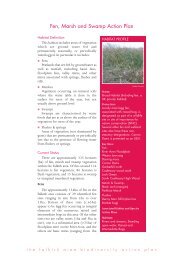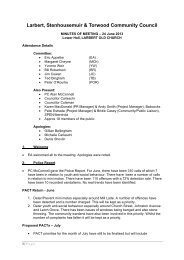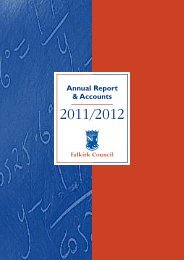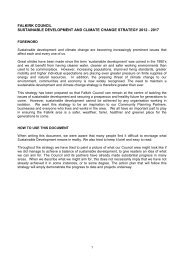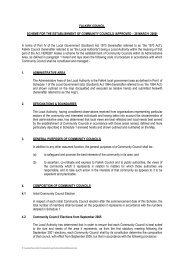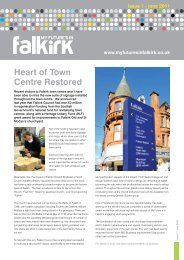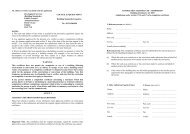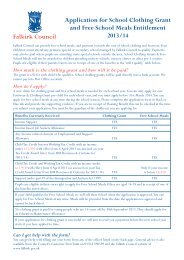Poverty & Inequalities Profile - Falkirk 2010 - Falkirk Council
Poverty & Inequalities Profile - Falkirk 2010 - Falkirk Council
Poverty & Inequalities Profile - Falkirk 2010 - Falkirk Council
Create successful ePaper yourself
Turn your PDF publications into a flip-book with our unique Google optimized e-Paper software.
<strong>Poverty</strong> & <strong>Inequalities</strong> <strong>Profile</strong><br />
<strong>Falkirk</strong> 2009<br />
Our Community Population<br />
The tables below provide details of <strong>Falkirk</strong>’s population in terms of age groups. Table 1 shows the age structure of<br />
<strong>Falkirk</strong>’s population in comparison to Scotland, which is similar to Scotland’s population. The population of the <strong>Falkirk</strong><br />
<strong>Council</strong> area has been growing since mid 1990’s, up 6.1% since 1994 to 152,480 in 2009. This increase will continue,<br />
the latest projections showing 157,600 by 2015 an increase of 3.3%. In 2020 the population is anticipated to increase<br />
by 6.2% up to 162,000. These increases will impact on all services bringing greater demands for service.<br />
Table 1: Population Estimates 2009<br />
Males Females<br />
Age Group <strong>Falkirk</strong> % Scotland % <strong>Falkirk</strong> % Scotland %<br />
Aged 0-15 14,330 19.4% 467,017 18.6% 13,829 17.6% 445,323 16.8%<br />
Working Age 49,014 66.3% 1,679,890 66.8% 45,841 58.3% 1,568,925 58.6%<br />
Pensionable Age 10,563 14.3% 368,381 14.6% 18,903 24.1% 664,464 24.8%<br />
Total 73,907 100.0% 2,515,288 100.0% 78,573 100.0% 2,678,712 100%<br />
Source GROS 2009 Mid Year Estimates<br />
An aging population is an issue that will affect <strong>Falkirk</strong>, Scotland, UK and Europe. The number of people aged over 65<br />
will increase by almost 3,900 by 2015, by 6,700 by 2020 and by almost 17,000 by 2033. For the very elderly, aged 85+,<br />
there will be an increase of 15% by 2015, 42% by 2020 and 157% by 2033.<br />
This will have a significant impact on demand for services with a consequent financial impact especially for Social Work<br />
and health services.<br />
Ethnicity<br />
The number of people in the <strong>Falkirk</strong> <strong>Council</strong> area population from an ethnic minority is very small – only 1,491 people<br />
in the 2001 Census which is the only reliable source. This represents 1% of the total population and is about half the<br />
Scottish total of 2%. 8.7% of the England & Wales’s population is of ethnic minority origin. Within Scotland, 5.5% of<br />
Glasgow’s population was from an ethnic minority and 4% of Edinburgh’s population.<br />
This does not mean that ethnicity is not an issue in our communities; our ethnic minority populations may be more<br />
isolated. It also means that it is difficult to obtain accurate statistical information on the impact of any discrimination<br />
they experience, for example in relation to educational attainment, income levels or employment status.<br />
The largest ethnic community in <strong>Falkirk</strong> is the Pakistani population which makes up 48% of the total. This followed<br />
by the mixed, Chinese and Indian populations.<br />
Migrant Workers<br />
Information on the numbers of immigrants is not comprehensive. The most inclusive survey is the Census, however,<br />
the last Census was carried out in 2001 and this predates the accession of the A8 states. Research has found that<br />
most migrant workers from the A8 nations only intend to stay for less than a year. It is therefore difficult to ascertain<br />
accurate figures.<br />
Table 2: Number NiNo Registrations<br />
<strong>Falkirk</strong> Forth Valley Scotland UK<br />
2002/03 140 380 14,750 343,230<br />
2003/04 140 410 15,980 373,500<br />
2004/05 180 540 23,400 435,350<br />
2005/06 460 1,300 41,410 663,060<br />
2006/07 610 1,620 51,880 705,840<br />
2007/08 560 15,60 52,410 733,090<br />
2008/09 440 1,360 4,624 686,110<br />
Total 2,530 5,610 204,454 3,940,180<br />
Source: Department for Work & Pensions<br />
National Insurance Number applications provide<br />
details on the numbers of overseas nationals<br />
intending to work in the UK. This captures those<br />
who seek employment, are self-employed and<br />
students who work part-time. However, records<br />
are not kept on those who leave the UK.<br />
Table 2 shows the number of migrant workers<br />
who have registered for a National Insurance<br />
Number in the <strong>Falkirk</strong> area in the last few years,<br />
together with comparative information for the<br />
Forth Valley area, Scotland and the UK.<br />
The average migrant worker in <strong>Falkirk</strong> is male, aged between 18-34, works 35-40 hours per week. 70% earn between<br />
£4.50-£5.99 per hour. This shows that most migrant workers are on the minimum wage, which is currently £5.73 per<br />
hour for adults aged 22+ and £4.77 for those aged 18-21.They are likely to work in Sector Based Training Schemes,<br />
transport, manufacturing, hospitality & catering or administration & business services. 53% of migrant workers intend<br />
to stay for a period of 3 months or less.



